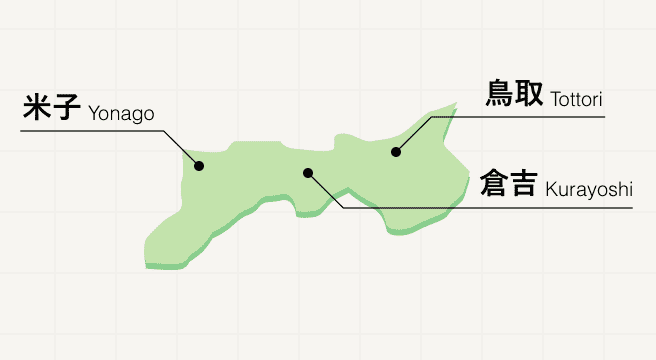Street Spots in Tottori Area
Area
-
-
Tottori
-
-
Tottori

Category


-
- Mizuki Shigeru Road
-
4.0797 Reviews
- Travel / Tourism
- Sakai City, Tottori Prefecture
- The local nickname for the shopping arcade which extends from Sakaiminato Station to the Mizuki Shigeru Memorial Museum. The area is a central part of the book “Yokai no Machi,” a book written by manga artist Shigeru Mizuki about his hometown of Sakaiminato City. The road is lined with numerous bronze statues of “yokai,” Japanese folk monsters that were a major focus of Mizuki’s work. The station, arcade shops, police boxes, street lights, and parks in the area all have been decorated with a yokai world theme. Some of the area’s many highlights include the kappa fountain, Youkai Shrine, and Gegege no Yokai Rakuen miniature theme park. This famous tourism destination is visited by large numbers of tourists not only from within the country but also around the world.
-
From the Sakaiminato port, took the shuttle to Shigeru Muzuki Rd, home of Gegege no Kitaro. A small town, where the main street was lined with over 150 bronze statues of this manga favorite. Small...
-
- Yunomachi Gallery
- Travel / Tourism
- Tottori Tohaku-gun Misasacho
- A group of shops and inns located in central Misasa Onsen, with its 800-year history. Primarily on the main street through the Hot Spring town, there are about 18 locations with galleries open to the public. Walking around viewing the excellent collections while taking in the atmosphere of the hot spring town gets good reviews. There are many exhibits that can only be seen there, such as displays of traditional Japanese indigo dyeing techniques and frog dolls from all over the world recalling the Kajika Frog of the Misasa River.
-
- Itaibara Village
- Travel / Tourism
- Tottori Yazu-gun Chizucho Ichinose
- This village, designated a Preservation District for Groups of Traditional Buildings, is one of only a very few found anywhere in the country which features virtually unaltered traditional mountain village scenery. In the Edo period, the village was a flourishing center of agriculture and charcoal production, while in the Meiji period it thrived via the silkworm cultivation industry. Here visitors can also taste the good old fashioned culinary delights of a Japanese farming village through establishments operating out of restored old homes such as a teahouse which makes teas using the area's delicious water, and a restaurant where you can eat rice made using a traditional kama stove. The village also boasts stunningly beautiful fall foliage in autumn.
-
- Yonago’s White-Walled Dozo Storehouses
- Travel / Tourism
- Tottori Yonago-shi Tenjinmachi
-
- Teramachi-dori Street
- Travel / Tourism
- Tottori Yonago-shi Teramachi
- A street through the Teramachi neighborhood, not far from the Kamo River. There are nine Buddhist temples along the roughly 400-meter road. An unusual arrangement in Japan, the temples were transferred here and rebuilt from various places around Hoki province when Yonago Castle was constructed. Each has a different style, to give you a wide sampling of Buddhist art and architecture. Some of these temples are particularly historic: Ankokuji Temple had branches built in various provinces by the Ashikaga clan during the Muromachi Period, and Myozenji Temple has ties to the Nanbokucho Period warrior Kojima Takanori.
-
- Kamogawa Riverside
- Travel / Tourism
- Tottori Yonago-shi Odakamachi
Tottori Areas

Tottori prefecture is Japanese seasonal diversity at its best: Huge sand dunes cover the north coast, making for the perfect summer beach trip complete with the unexpected addition of camels; November brings the delectable snow crab, while winter around Mount Daisen, the Chugoku region’s highest mountain, promises snow sports and magical views.
Best of Tottori
Search by Region
-
- Hokkaido / Tohoku
- Hokkaido
- Aomori
- Iwate
- Miyagi
- Akita
- Yamagata
- Fukushima
-
- Kanto
- Ibaraki
- Tochigi
- Gunma
- Saitama
- Chiba
- Tokyo
- Kanagawa
-
- Koshinetsu / Hokuriku
- Niigata
- Toyama
- Ishikawa
- Fukui
- Yamanashi
- Nagano
-
- Tokai
- Gifu
- Shizuoka
- Aichi
- Mie
-
- Kinki
- Shiga
- Kyoto
- Osaka
- Hyogo
- Nara
- Wakayama
-
- Chugoku
- Tottori
- Shimane
- Okayama
- Hiroshima
- Yamaguchi
-
- Shikoku
- Tokushima
- Kagawa
- Ehime
- Kochi
-
- Kyushu / Okinawa
- Fukuoka
- Saga
- Nagasaki
- Kumamoto
- Oita
- Miyazaki
- Kagoshima
- Okinawa


















